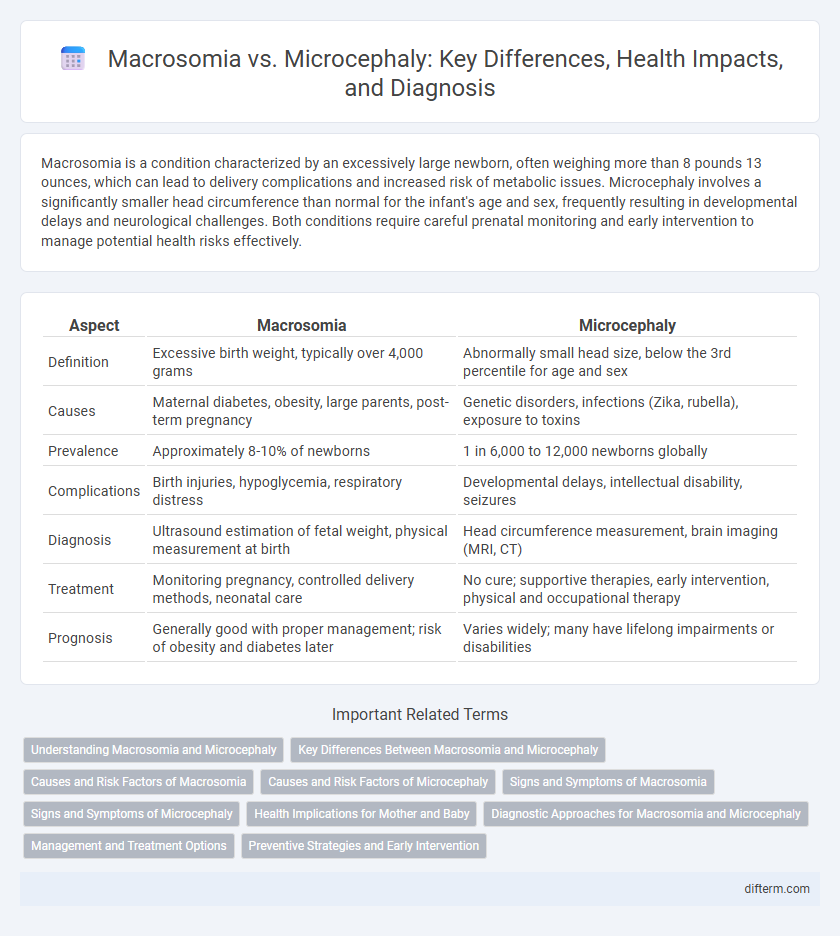Macrosomia is a condition characterized by an excessively large newborn, often weighing more than 8 pounds 13 ounces, which can lead to delivery complications and increased risk of metabolic issues. Microcephaly involves a significantly smaller head circumference than normal for the infant's age and sex, frequently resulting in developmental delays and neurological challenges. Both conditions require careful prenatal monitoring and early intervention to manage potential health risks effectively.
Table of Comparison
| Aspect | Macrosomia | Microcephaly |
|---|---|---|
| Definition | Excessive birth weight, typically over 4,000 grams | Abnormally small head size, below the 3rd percentile for age and sex |
| Causes | Maternal diabetes, obesity, large parents, post-term pregnancy | Genetic disorders, infections (Zika, rubella), exposure to toxins |
| Prevalence | Approximately 8-10% of newborns | 1 in 6,000 to 12,000 newborns globally |
| Complications | Birth injuries, hypoglycemia, respiratory distress | Developmental delays, intellectual disability, seizures |
| Diagnosis | Ultrasound estimation of fetal weight, physical measurement at birth | Head circumference measurement, brain imaging (MRI, CT) |
| Treatment | Monitoring pregnancy, controlled delivery methods, neonatal care | No cure; supportive therapies, early intervention, physical and occupational therapy |
| Prognosis | Generally good with proper management; risk of obesity and diabetes later | Varies widely; many have lifelong impairments or disabilities |
Understanding Macrosomia and Microcephaly
Macrosomia refers to a condition where a newborn has an excessive birth weight, typically over 8 pounds 13 ounces (4,000 grams), often linked to maternal diabetes and can increase risks during delivery. Microcephaly is characterized by a significantly smaller head circumference, usually due to abnormal brain development, leading to potential developmental delays and neurological impairments. Understanding the distinct causes, diagnostic criteria, and potential health outcomes of macrosomia and microcephaly is critical for early intervention and tailored perinatal care.
Key Differences Between Macrosomia and Microcephaly
Macrosomia refers to a condition where a newborn has an excessive birth weight, typically over 8 pounds 13 ounces (4,000 grams), while microcephaly is characterized by a significantly smaller head circumference, often below the third percentile for age and sex. Macrosomia primarily affects body size and increases risks of birth injuries and metabolic complications, whereas microcephaly impacts brain development, leading to neurological impairments and developmental delays. The causes differ, with macrosomia commonly related to maternal diabetes and obesity, and microcephaly linked to genetic factors, infections, or prenatal exposure to toxins.
Causes and Risk Factors of Macrosomia
Macrosomia is primarily caused by maternal diabetes, excessive maternal weight gain, and genetic predisposition, leading to an abnormally large newborn typically weighing over 4,000 grams. Risk factors include prolonged pregnancy, maternal obesity, and a history of macrosomic infants, which increase the likelihood of fetal overgrowth due to elevated insulin and nutrient levels. In contrast, microcephaly originates from genetic mutations, infections during pregnancy, or prenatal exposure to harmful substances, resulting in an abnormally small head size rather than excessive fetal growth.
Causes and Risk Factors of Microcephaly
Microcephaly is primarily caused by genetic abnormalities, prenatal infections such as Zika virus, and exposure to harmful substances like alcohol or certain drugs during pregnancy. Risk factors include maternal malnutrition, uncontrolled diabetes, and severe malformations during fetal brain development. Early diagnosis and monitoring of these risk factors are crucial for managing potential developmental complications.
Signs and Symptoms of Macrosomia
Macrosomia is characterized by an abnormally large newborn, typically weighing over 8 pounds 13 ounces (4,000 grams) at birth, presenting signs such as increased birth length and a disproportionately large head circumference. Symptoms often include difficulty during delivery due to the baby's size, such as shoulder dystocia, and increased risk of low blood sugar (hypoglycemia) after birth. Identifying these signs early helps manage potential complications for both the infant and mother.
Signs and Symptoms of Microcephaly
Microcephaly is characterized by a significantly smaller head circumference compared to age and sex norms, often leading to developmental delays and intellectual disabilities. Common signs include seizures, impaired motor functions, speech difficulties, and abnormal facial features. Early diagnosis through head circumference measurements and neuroimaging is essential for managing symptoms and providing supportive care.
Health Implications for Mother and Baby
Macrosomia, characterized by a newborn's excessive birth weight typically over 8 pounds 13 ounces, increases risks of delivery complications, such as cesarean section, birth injuries, and postpartum hemorrhage for the mother. Conversely, microcephaly, marked by a significantly smaller head circumference often linked to brain underdevelopment, poses long-term developmental challenges and neurological impairments for the baby. Both conditions require specialized prenatal monitoring to mitigate adverse outcomes and ensure tailored healthcare strategies for maternal and infant well-being.
Diagnostic Approaches for Macrosomia and Microcephaly
Diagnostic approaches for macrosomia primarily involve prenatal ultrasound measurements of fetal weight, abdominal circumference, and femur length to estimate excessive fetal growth, while maternal risk factors such as diabetes or obesity are also evaluated. Microcephaly diagnosis relies on measuring the newborn's head circumference, comparing it with standardized growth charts, and may include neuroimaging modalities like MRI and CT scans to assess brain development abnormalities. Genetic testing and prenatal screening for infections or environmental exposures contribute to accurate differentiation and early diagnosis of both conditions.
Management and Treatment Options
Management of macrosomia centers on careful monitoring of fetal growth through ultrasound and planning for potential delivery complications, often involving scheduled cesarean section to reduce birth trauma. Treatment of microcephaly focuses on early intervention therapies such as physical, occupational, and speech therapy to support developmental delays, with no curative medical therapy available. Both conditions require multidisciplinary care involving obstetricians, neonatologists, and pediatric neurologists to optimize outcomes.
Preventive Strategies and Early Intervention
Preventive strategies for macrosomia focus on maternal health management, including controlling gestational diabetes through diet and regular prenatal check-ups to reduce the risk of excessive fetal growth. Early intervention for microcephaly involves prompt neurological assessments and developmental therapies to address cognitive and motor delays, enhancing long-term outcomes. Both conditions benefit from multidisciplinary care teams to monitor and support healthy fetal development from pregnancy through infancy.
Macrosomia vs Microcephaly Infographic

 difterm.com
difterm.com